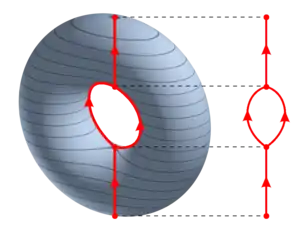Reeb graph
A Reeb graph[1] (named after Georges Reeb by René Thom) is a mathematical object reflecting the evolution of the level sets of a real-valued function on a manifold.[2] According to [3] a similar concept was introduced by G.M. Adelson-Velskii and A.S. Kronrod and applied to analysis of Hilbert's thirteenth problem.[4] Proposed by G. Reeb as a tool in Morse theory,[5] Reeb graphs are the natural tool to study multivalued functional relationships between 2D scalar fields , , and arising from the conditions and , because these relationships are single-valued when restricted to a region associated with an individual edge of the Reeb graph. This general principle was first used to study neutral surfaces in oceanography.[6]

Reeb graphs have also found a wide variety of applications in computational geometry and computer graphics,[1][7] including computer aided geometric design, topology-based shape matching,[8][9][10] topological data analysis,[11] topological simplification and cleaning, surface segmentation [12] and parametrization, efficient computation of level sets, and geometrical thermodynamics.[3] In a special case of a function on a flat space (technically a simply connected domain), the Reeb graph forms a polytree and is also called a contour tree.[13]
Level set graphs help statistical inference related to estimating probability density functions and regression functions, and they can be used in cluster analysis and function optimization, among other things. [14]
Formal definition
Given a topological space X and a continuous function f: X → R, define an equivalence relation ∼ on X where p∼q whenever p and q belong to the same connected component of a single level set f−1(c) for some real c. The Reeb graph is the quotient space X /∼ endowed with the quotient topology.
Description for Morse functions
If f is a Morse function with distinct critical values, the Reeb graph can be described more explicitly. Its nodes, or vertices, correspond to the critical level sets f−1(c). The pattern in which the arcs, or edges, meet at the nodes/vertices reflects the change in topology of the level set f−1(t) as t passes through the critical value c. For example, if c is a minimum or a maximum of f, a component is created or destroyed; consequently, an arc originates or terminates at the corresponding node, which has degree 1. If c is a saddle point of index 1 and two components of f−1(t) merge at t = c as t increases, the corresponding vertex of the Reeb graph has degree 3 and looks like the letter "Y"; the same reasoning applies if the index of c is dim X−1 and a component of f−1(c) splits into two.
References
- Y. Shinagawa, T.L. Kunii, and Y.L. Kergosien, 1991. Surface coding based on Morse theory. IEEE Computer Graphics and Applications, 11(5), pp.66-78
- Harish Doraiswamy, Vijay Natarajan, Efficient algorithms for computing Reeb graphs, Computational Geometry 42 (2009) 606–616
- Gorban, Alexander N. (2013). "Thermodynamic Tree: The Space of Admissible Paths". SIAM Journal on Applied Dynamical Systems. 12 (1): 246–278. arXiv:1201.6315. doi:10.1137/120866919.
- G. M. Adelson-Velskii, A. S. Kronrod, About level sets of continuous functions with partial derivatives, Dokl. Akad. Nauk SSSR, 49 (4) (1945), pp. 239–241.
- G. Reeb, Sur les points singuliers d’une forme de Pfaff complètement intégrable ou d’une fonction numérique, C. R. Acad. Sci. Paris 222 (1946) 847–849
- Stanley, Geoffrey J. (June 2019). "Neutral surface topology". Ocean Modelling. 138: 88–106. arXiv:1903.10091. doi:10.1016/j.ocemod.2019.01.008.
- Y. Shinagawa and T.L. Kunii, 1991. Constructing a Reeb graph automatically from cross sections. IEEE Computer Graphics and Applications, 11(6), pp.44-51.
- Pascucci, Valerio; Scorzelli, Giorgio; Bremer, Peer-Timo; Mascarenhas, Ajith (2007). "Robust On-line Computation of Reeb Graphs: Simplicity and Speed" (PDF). ACM Transactions on Graphics. 26 (3): 58.1–58.9. doi:10.1145/1276377.1276449.
- M. Hilaga, Y. Shinagawa, T. Kohmura and T.L. Kunii, 2001, August. Topology matching for fully automatic similarity estimation of 3D shapes. In Proceedings of the 28th annual conference on Computer graphics and interactive techniques (pp. 203-212). ACM.
- Tung, Tony; Schmitt, Francis (2005). "The Augmented Multiresolution Reeb Graph Approach for Content-Based Retrieval of 3D Shapes". International Journal of Shape Modeling. 11 (1): 91–120. doi:10.1142/S0218654305000748.
- "the Topology ToolKit".
- Hajij, Mustafa; Rosen, Paul (2020). "An Efficient Data Retrieval Parallel Reeb Graph Algorithm". MDPI. 13: 258. doi:10.3390/a13100258.
- Carr, Hamish; Snoeyink, Jack; Axen, Ulrike (2000), "Computing contour trees in all dimensions", Proc. 11th ACM-SIAM Symposium on Discrete Algorithms (SODA 2000), pp. 918–926.
- Klemelä, Jussi (2018). "Level set tree methods". Wiley Interdisciplinary Reviews: Computational Statistics. 10 (5): e1436. doi:10.1002/wics.1436.